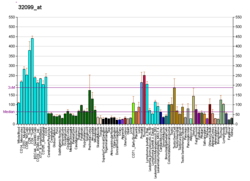SAFB2
Scaffold attachment factor B2 is a protein that in humans is encoded by the SAFB2 gene.[5][6]
Interactions
SAFB2 has been shown to interact with Estrogen receptor alpha[5] and SAFB.[5]
References
- 1 2 3 GRCh38: Ensembl release 89: ENSG00000130254 - Ensembl, May 2017
- 1 2 3 GRCm38: Ensembl release 89: ENSMUSG00000042625 - Ensembl, May 2017
- ↑ "Human PubMed Reference:".
- ↑ "Mouse PubMed Reference:".
- 1 2 3 Townson SM, Dobrzycka KM, Lee AV, Air M, Deng W, Kang K, Jiang S, Kioka N, Michaelis K, Oesterreich S (May 2003). "SAFB2, a new scaffold attachment factor homolog and estrogen receptor corepressor". J. Biol. Chem. 278 (22): 20059–68. doi:10.1074/jbc.M212988200. PMID 12660241.
- ↑ "Entrez Gene: SAFB2 scaffold attachment factor B2".
Further reading
- Oesterreich S (2003). "Scaffold attachment factors SAFB1 and SAFB2: Innocent bystanders or critical players in breast tumorigenesis?". J. Cell. Biochem. 90 (4): 653–61. doi:10.1002/jcb.10685. PMID 14587024.
- Nagase T, Seki N, Tanaka A, Ishikawa K, Nomura N (1995). "Prediction of the coding sequences of unidentified human genes. IV. The coding sequences of 40 new genes (KIAA0121-KIAA0160) deduced by analysis of cDNA clones from human cell line KG-1". DNA Res. 2 (4): 167–74, 199–210. doi:10.1093/dnares/2.4.167. PMID 8590280.
- Beausoleil SA, Jedrychowski M, Schwartz D, Elias JE, Villén J, Li J, Cohn MA, Cantley LC, Gygi SP (2004). "Large-scale characterization of HeLa cell nuclear phosphoproteins". Proc. Natl. Acad. Sci. U.S.A. 101 (33): 12130–5. doi:10.1073/pnas.0404720101. PMC 514446. PMID 15302935.
- Ballif BA, Villén J, Beausoleil SA, Schwartz D, Gygi SP (2004). "Phosphoproteomic analysis of the developing mouse brain". Mol. Cell. Proteomics. 3 (11): 1093–101. doi:10.1074/mcp.M400085-MCP200. PMID 15345747.
- Olsen JV, Blagoev B, Gnad F, Macek B, Kumar C, Mortensen P, Mann M (2006). "Global, in vivo, and site-specific phosphorylation dynamics in signaling networks". Cell. 127 (3): 635–48. doi:10.1016/j.cell.2006.09.026. PMID 17081983.
This article is issued from
Wikipedia.
The text is licensed under Creative Commons - Attribution - Sharealike.
Additional terms may apply for the media files.





